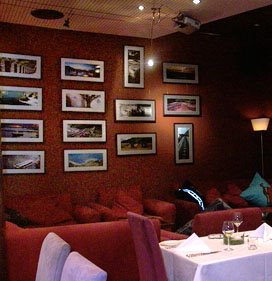
A journalist acquaintance (Russians have always frowned upon the casual use by English speakers of the word "friend"), Andrew Osborn, has written an article in today's edition of The Independent of London about plans by British architect Sir Norman Foster to redesign the city centre right next to the Kremlin.
I've seen vague accounts about this scheme before, but it is the first time I've read a detailed description of what is being planned to fill up the 52,610 square meter area to be vacated when the Soviet-era Rossiya Hotel, one of the USSR's most hideous landmarks, is finally torn down from its prestigious riverside location.
The Rossiya was once trumpeted as the biggest hotel in the world when it opened in 1967. It admittedly had its uses - it provided inexpensive accommodation in a ridiculously expensive city. One could plan a summer trip to Moscow without needing to make a reservation simply by walking into the lobby and asking for one of its almost 3,000 hotel rooms, most of which were available for under US$100. Of course, in practice foreign visitors would have to make some kind of reservation anyway in order to secure a visa from a Russian Embassy overseas but at least there was some reassurance in theory. With this behemoth (two of its ilk preceded it - the 434-room Intourist Hotel was demolished in 2002, and the 1000-room Moskva in 2004 - while another, the Minsk, has been shut down) gradually being razed, the hotel business in Moscow appears inexorably headed upmarket.
Anyway the plans for the revival of the district, which centers on the rebirth of Zaryadye, the pre-revolutionary name of the area, give long-time residents of Moscow, a 860-year-old city currently undergoing its most extensive makeover since Stalin tinkered with it in the 1930s, something to look forward to in the next couple of years. Andrew writes thus:
Andrew appears to have scooped other papers with his revelation about the Zaryadye plans as well as a commission to build a Russian version of Disneyland in an area called Nagatino Poima, a spit of land in southern Moscow said to spread over 1.858 square meters.
I've seen vague accounts about this scheme before, but it is the first time I've read a detailed description of what is being planned to fill up the 52,610 square meter area to be vacated when the Soviet-era Rossiya Hotel, one of the USSR's most hideous landmarks, is finally torn down from its prestigious riverside location.
The Rossiya was once trumpeted as the biggest hotel in the world when it opened in 1967. It admittedly had its uses - it provided inexpensive accommodation in a ridiculously expensive city. One could plan a summer trip to Moscow without needing to make a reservation simply by walking into the lobby and asking for one of its almost 3,000 hotel rooms, most of which were available for under US$100. Of course, in practice foreign visitors would have to make some kind of reservation anyway in order to secure a visa from a Russian Embassy overseas but at least there was some reassurance in theory. With this behemoth (two of its ilk preceded it - the 434-room Intourist Hotel was demolished in 2002, and the 1000-room Moskva in 2004 - while another, the Minsk, has been shut down) gradually being razed, the hotel business in Moscow appears inexorably headed upmarket.
Anyway the plans for the revival of the district, which centers on the rebirth of Zaryadye, the pre-revolutionary name of the area, give long-time residents of Moscow, a 860-year-old city currently undergoing its most extensive makeover since Stalin tinkered with it in the 1930s, something to look forward to in the next couple of years. Andrew writes thus:
When construction of the new district is finished in 2008, it will be a self-contained town-within-a-town, including hotels, offices, shops, cafés, restaurants, subterranean parking space for 2,000 cars, a concert hall, cinemas, a huge public square and a terminal for boats on the adjacent river Moskva.Much has been bruited about the involvement by a foreign architect in the Russian capital's prestige project. Foster is said to have won over the property developers with his design for the Reichstag in Berlin and the "Gherkin" in London. In Russia, he has been contracted for the construction of Europe's tallest tower in the Moskva-City district and the Holland Island project in St Petersburg.
The design of the buildings' façade is being left to Russian architects who want to erect pastel-coloured recreations of 18th- and 19th-century Moscow mansions so as not to jar with the Kremlin next door. But Sir Norman will be responsible for creating all the inside space and for coordinating the overall project.
The buildings will not be higher than eight storeys so as not to overshadow the Kremlin. An entire pre-revolutionary street, called Velikaya Ulitsa, will be recreated, a church painstakingly resurrected, and the area's 16th-century walls rebuilt.
Andrew appears to have scooped other papers with his revelation about the Zaryadye plans as well as a commission to build a Russian version of Disneyland in an area called Nagatino Poima, a spit of land in southern Moscow said to spread over 1.858 square meters.










